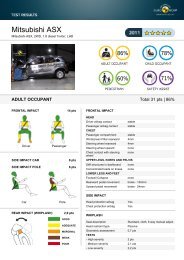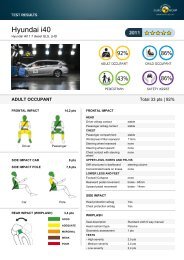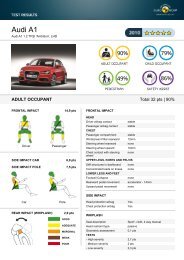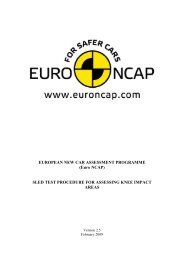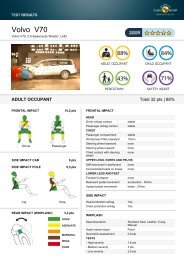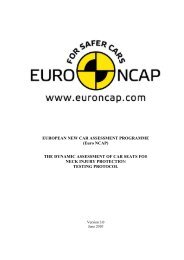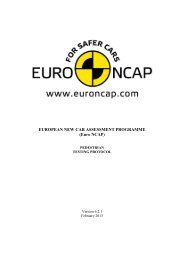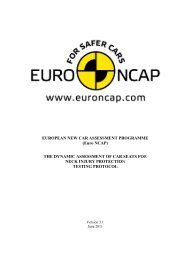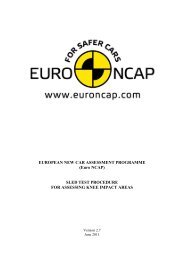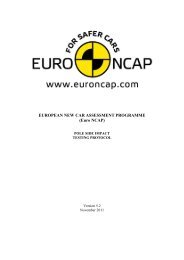Pedestrian Test Protocol - Euro NCAP
Pedestrian Test Protocol - Euro NCAP
Pedestrian Test Protocol - Euro NCAP
Create successful ePaper yourself
Turn your PDF publications into a flip-book with our unique Google optimized e-Paper software.
lie between 1500 mm and 1700 mm the structure being tested will determine the<br />
headform to be used, see Section 3.8.9.<br />
12.3.5 The position of the ‘test location’ describes the location of the grid point and will<br />
always determine which impactor shall be used; this will also be the case where the<br />
grid point is not coincidental with the point of first contact. For example, between<br />
1500 mm and 1700 mm a grid point on the windscreen base will be impacted by the<br />
adult headform even if the point of first contact is with the rear edge of the bonnet.<br />
12.3.6 Roll the vehicle forwards to give the desired free flight distance.<br />
12.3.7 Adjust the propulsion system so that it can fire the headform at the grid point with the<br />
correct angle of incidence and is aimed at the impact point.<br />
12.3.8 The direction of impact shall be in the fore and aft vertical plane of the section of the<br />
vehicle to be tested. The tolerance for this direction is ±2°. The direction of impact of<br />
tests to the bonnet top shall be downward and rearward, as if the vehicle were on the<br />
ground. The angle of impact for tests with the child/small adult headform impactor<br />
shall always be 50° ±2° to the Ground Reference Level. For tests with the adult<br />
headform impactor the angle of impact shall always be 65° ±2° to the Ground<br />
Reference Level. The effect of gravity shall be taken into account when the impact<br />
angle is obtained from measurements taken before the time of first contact.<br />
12.3.9 The centreline of the headform impactor shall be within a ±10mm tolerance to the<br />
selected grid point.<br />
12.3.10 Set the speed control on the propulsion system to give a velocity of 11.1 ±0.2m/s at the<br />
point of first contact. The velocity measuring device should be able to measure to an<br />
accuracy of at least 0.02m/s. The effect of gravity shall be taken into account when<br />
the impact velocity is obtained from measurements taken before the point of first<br />
contact.<br />
12.3.11 Fire the propulsion system.<br />
12.4 <strong>Test</strong> Procedure - Post <strong>Test</strong><br />
12.4.1 Take at least two still photographs of the resultant dent, one from the side and one<br />
from the front. Each photograph shall have some means of identifying the vehicle and<br />
test location. The preferred method shall be to use unique run numbers for each test.<br />
12.4.2 Additional photographs may be required for an individual test at the Project Manager’s<br />
discretion.<br />
12.4.3 Check that no CAC has been exceeded before conducting the next test, if this has<br />
occurred then the impactor must be re-certified before the next test.<br />
12.4.4 Replace any damaged part of the vehicle which would affect the results of the next test<br />
with new parts according to Section 8.3.<br />
12.4.5 Repeat procedure for the next impact location.<br />
Where a specified requirement has not been met, <strong>Euro</strong> <strong>NCAP</strong> reserves the right to decide<br />
whether or not the test will be considered as valid.<br />
Version 7.0<br />
March 2013<br />
50



